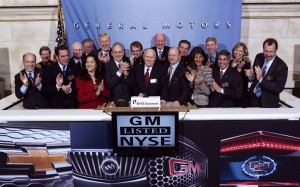
General Motors CEO Dan Akerson (center) rings the opening bell at the New York Stock Exchange Wednesday morning.
General Motors Co.’s new stock closed above the IPO asking price, reaping more than $20 billion for the principal sellers — including the U.S. Treasury – finishing first-day trading on the New York Stock Exchange at $33 per share.
“They marketed the heck out of this thing. It was bigger than the iPad and the iPhone,” said one analyst, who credited the apparent success of the GM IPO to the skillful sales job done by CEO Dan Akerson. Akerson marked the milestone day by ringing the opening bell at the New York Stock Exchange, colleagues GM CFO Chris Liddell and vice chairman Steve Girsky at his side.
Akerson said the IPO was a great day for the company, which can put aside its government motors tag for good. Before the IPO, the U.S. Treasury owned 61% of GM under the terms of the 2009 bailout. After the IPO the stake was reduced to about 33 percent, Liddell said, adding that when additional shares demanded by underwriters are accounted for, and while considering the convertible preferred stock also issued through the IPO, the Treasury share slips closer to 28%.
Liddell also noted that while some sovereign wealth funds from abroad did participate in the initial public offering, 90% of the new GM shares were sold within North America. The allocations to various buyers included a $4 billion for retail buyers in the U.S.
“We thought it was important for there to be a retail allocation,” Liddell said.
Akerson said the IPO was a tribute to GM’s employees, as well as the strength of the company’s product line, which is now led by the Chevrolet Volt, which this week alone was named “Green Car of The Year,” Motor Trend Magazine’s “Car of the Year,” and Automobile Magazine’s “Car of the Year.”
The CEO, a long-time telecomm expert who joined GM after last year’s bailout, noted that the giant automaker is a very different company from the one that was swept up in crisis in 2008, plunging into Chapter 11 in May of the following year.
“We’ve learned some things” he said.
President Barack Obama also hailed the GM IPO, declaring that, “General Motors’ initial public offering marks a major milestone in the turnaround of not just an iconic company but the entire American auto industry. Through the IPO, the government will cut its stake in GM by nearly half, continuing our disciplined commitment to exit this investment while protecting the American taxpayer.”
Michigan Senator Carl Levin also said the success of the IPO vindicated the original decision to bailout GM and Chrysler.
“The steps taken in 2008 and 2009 to preserve this cornerstone of the U.S. economy saved well over one million jobs and put these companies in a position to lead us into the next generation of automotive technology. Their success demonstrates the wisdom of President Obama’s decision to help them through their painful restructuring, despite the criticism of those who wanted to abandon our domestic auto industry,” Levin said.
Akerson, meanwhile, stressed he was grateful for the government support of GM and said the IPO. He also stressed the U.S. Treasury has been a patient investor and has left the key decisions to the company’s board of directors.
The question is whether the IPO – and the subsequent reduction in the government’s stake – will win over skeptics, many of whom have taken to calling the carmaker “Government Motors.” Some potential buyers, GM has acknowledged, refuse to buy its products because of the bailout.
“I would say the average taxpayer in the U.S. would take this as very positive,” Akerson suggested, during a conference call with reporters.
Things certainly did take a positive turn in recent days. The original plan called for selling 365 million shares of GM stock at between $26 and $29 a share. By early this week, GM had boosted the price range to between $32 and $33, while it then increased the availability of common shares by a third, and added 20 million more preferred shares. At $50 apiece, that preferred stock pumped $4 billion into GM’s bank account.
Including an over-allotment, insiders say the IPO will ultimately come to about $23 billion, making it the latest initial public offering in history, well exceeding the $19.7 billion raised by Visa in 2008.
Paul A. Eisenstein contributed to this report.
